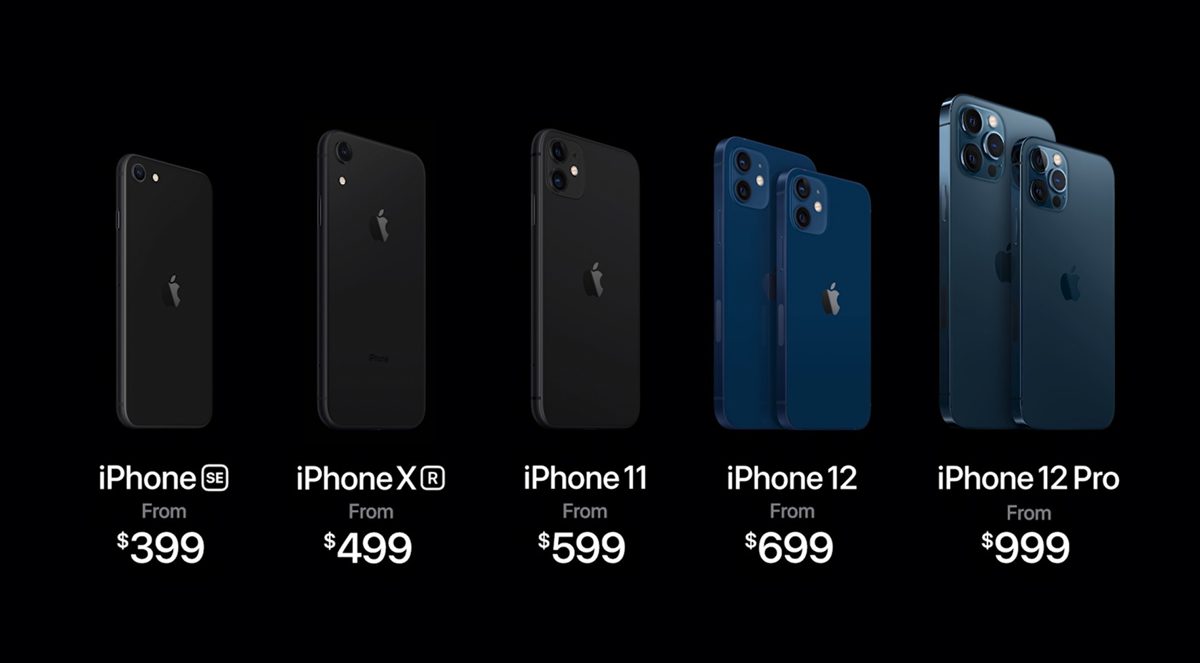
iPhone day has finally arrived. It’s a few weeks late this year, but Apple revealed the iPhone 12, an entire family of four new iPhones across a range of prices. The phones are meant to tempt users new and advanced with a bevy of features such as fresh colors, 5G, photography, gaming, and more.
These are some of the most exciting new iPhones we’ve seen from Apple in years, but are they enough to tempt you away from Android?
Apple iPhone 12: Here are the basics
The iPhone now comes in four models: the iPhone 12 Mini, the iPhone 12, the iPhone 12 Pro, and the iPhone 12 Pro Max. Screen sizes vary across models, as do colors, camera configurations, and storage allotments.
All the phones offer 5G and will be available from more than 100 carriers across 30 regions. The company made a big deal about 5G, and featured Hans Vestberg, the CEO of Verizon Wireless, during the presentation. Both Apple and Verizon claim some iPhones will reach between 3.5 and 4Gbps download speeds and 200Mbps upload speeds. “5G is the most exciting step yet,” said Apple CEO Tim Cook during the presentation.
Each includes a Super Retina XDR OLED display, which is protected by a new technology called Ceramic Shield. Apple claims this new material is four times more break resistant than Gorilla Glass. The OLED tech offers normal brightness of 625 nits and can reach peaks of 1200 nits. Pixel density is about the same across all four at 460ppi and contrast can reach as high as 2 million to 1. The iPhones support HDR video formats, as well as Dolby Vision.
The A14 Bionic is the heart of all four new iPhone 12 models. Apple called it “the fastest chip ever in a smartphone.” It reaches a significant milestone: it’s built on a 5nm process. That allowed Apple to bit 11.8 billion transistors on the chip, an increase of 40% compared to the A13. There are two high-performance cores and four efficiency cores in the A14, as well as a four-core GPU, ISP, and the Apple Neural Engine. Graphics are 50% faster, while machine learning tasks are 80% faster.
Then there’s MagSafe. Apple rejuvenated its wireless charging technology to make it more convenient than ever. Similar to how its MagSafe chargers worked on MacBooks, the iPhone 12 range features magnets that help align the phone with wireless chargers. It’s backward compatible with all existing Qi wireless chargers, but is particularly suited to a new family of wireless charging accessories from Apple. The iPhones support up to 15W wireless charging, which is an improvement over the wireless charging speeds in the iPhone 11 family.
All the new iPhones ship with iOS 14, which introduced several significant features last month. For example, home screen widgets are now available to iPhones, which give owners more creative control over their home screen experience.
These are the core features offered on the range of iPhone 12 models. Now let’s dig into specifics.
What are the iPhone 12’s features?
The iPhone 12 Mini and iPhone 12 are essentially the same phone, only differing in size. The same is mostly true of the iPhone 12 Pro and iPhone 12 Pro Max. Where the iPhone 12 is the iPhone most people should probably buy, the iPhone 12 Pro and Pro Max are for power users who want the ultimate iPhone.
Let’s start with the non-Pro models. The iPhone 12 Mini and iPhone 12 each include the 5G, display, processor, and software noted above. The 12 Mini has a 5.4-inch display (2,340 x 1,080) and the 12 has a 6.1-inch screen (2,532 x 1,170). The boat-shaped notch remains. While the front has the Ceramic Shield, the rear is protected with Gorilla Glass. The frame is made from aluminum. The entire chassis is rated IP68 for protection from dirt and water.
ou’ll find a two-camera system on the iPhone 12 Mini and iPhone 12. Both the ultra-wide angle and standard lenses have 12MP sensors. Apple says the ultra-wide has an aperture of f/2.4 and a 120-degree field of view, while the standard camera has an aperture of f/1.6. Standard features include portrait mode with depth control, 5x digital zoom, sapphire crystal lens covers, 100% focus pixels, night mode, panorama, and OIS. Advanced features include Smart HDR 3, which brings out more detail and better adjusts for color, contrast, and noise. Deep Fusion and computational photography help blend images to generate the ultimate in contrast.
Video capture is rich. You’ll find 4k resolutions available at 24, 30, and 60fps, as well as Dolby Vision up to 30fps. Slow-motion support in 1080p reaches 240fps. Perhaps the most notable new feature is Night Mode Time-lapse. The camera’s extended dynamic range allows it to capture night scenes in time-lapse video formats.
The front, or TrueDepth, camera rates 12MP at f/2.2 and carries over many of the same capabilities as the main cameras, such as Night Mode, Deep Fusion, and Smart HDR 3.
With all that, what could the Pro models possible add to the equation?
First up, the materials. Where the iPhone 12 comes in aluminum, the iPhone 12 Pro and Pro Max step up to stainless steel. Moreover, gone are the fun colors in exchange for silver, graphite, gold, and pacific blue. The screens measure 6.1 inches (2,532 x 1,170) and 6.7 inches (2,778 x 1,284) across the diagonal for the Pro and Pro Max, respectively.
Where the Pro models really up the game comes in the camera department. They advance to three-camera systems and offer pro-level features unavailable to the regular models. The Pro offers 13mm ultra-wide, 26mm standard, and 52mm telephoto cameras, all at 12MP. This leads to 2x optical zoom and a total zoom range of 4x. The Pro Max offers 13mm ultra-wide, 26mm standard, and 65mm telephoto cameras, all at 12MP. This leads to 2.5x optical zoom and a total zoom range of 5x. Apple says the telephoto camera in the Pro Max, in particular, is its largest ever sensor and it allows in 87% more light than the predecessor.
Both Pro models feature LiDAR (light detecting and ranging), which adds an entirely new dimension of photography. Because LiDAR creates 3D maps of the environment, the Pro models are able to use LiDAR not only for augmented reality applications, but faster autofocus in the dark. Apple claims the iPhone Pro models can focus in the dark up to 6x faster than previous iPhones, which helps speed up the capture process. Moreover, focus will be accurate.
Photographers get Apple ProRAW, a new format that blends multi-frame processing to offer the best of both RAW and JPEG files in one. It offers the creative control over RAW with the simplicity of JPEG. This feature will arrive later this year.
Apple didn’t forget about video. The iPhone 12 Pro and Pro Max can capture 10-bit HDR video with up to 700 million colors. Moreover, the phones offer a live preview of the footage as you shoot. It can also record in Dolby Vision HDR, where every single frame is run through a histogram and processed by the A14 Bionic’s Neural Engine. You can even edit the Dolby Vision files directly on the iPhone.
There’s no USB-C. Instead, you’ll get a USB-C-to-Lightning cable and no charger in the box. Nor do you get headphones.












